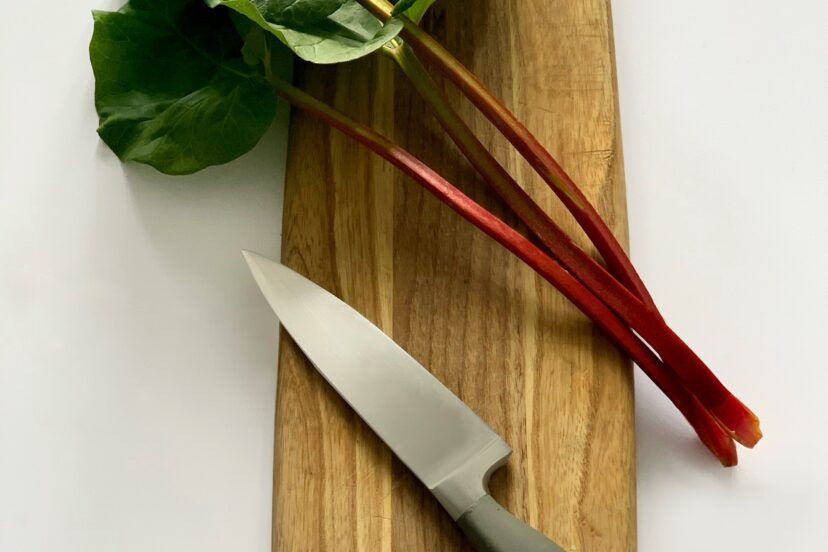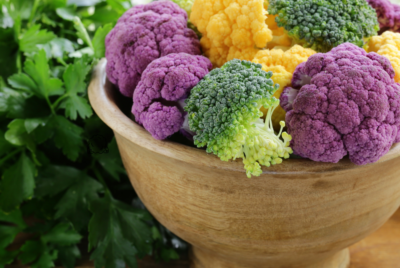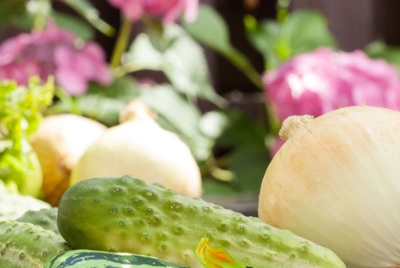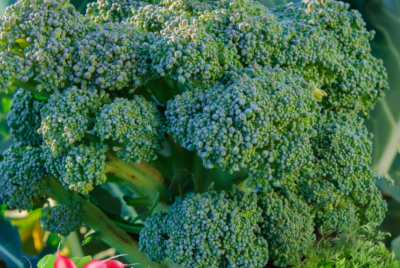Rhubarb Companion Plants
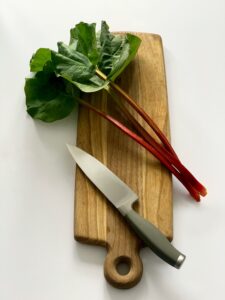
The Art of Companion Planting with Rhubarb: A Comprehensive Guide
I. Introduction to Companion Planting
Companion planting is a time-honored gardening technique that involves placing different plants in close proximity for mutual benefit.
This method is based on the understanding that certain plants can enhance each other’s growth, improve soil health, and even provide natural pest control.
It’s an approach deeply rooted in permaculture and organic gardening philosophies, aiming to create a harmonious and sustainable ecosystem within your garden.
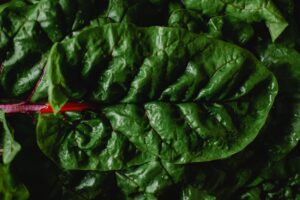
1.What is Companion Planting?
At its core, companion planting is about understanding the relationships between different plants and using these relationships to create a more productive and healthy garden. This practice goes beyond just physical spacing; it’s about creating plant synergies. For instance, some plants may repel pests that commonly affect another plant, or they might attract beneficial insects that aid in pollination. Some plants, when grown together, can improve soil nutrients, which benefits their neighbors.
2.Why Rhubarb is a Great Choice for Companion Planting?
Rhubarb is an excellent candidate for companion planting for several reasons. Firstly, it’s a hardy perennial, meaning once it’s established, it can provide benefits to your garden year after year. Its large leaves provide ample shade, which can be beneficial for plants that require protection from intense sun. This shade can help conserve moisture in the soil, benefiting neighboring plants that prefer cooler, moister soil conditions.
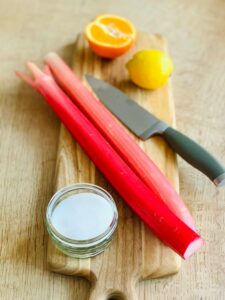
Furthermore, rhubarb has a reputation for being a natural pest deterrent. It’s believed to repel some common garden pests, making it a valuable ally in organic pest management strategies.
The presence of rhubarb can help reduce the need for chemical pesticides, leading to a healthier, more eco-friendly garden environment.
Additionally, rhubarb can add aesthetic value to a garden. Its bold, large leaves and striking red stalks can create visual interest and contrast, enhancing the overall beauty of your garden space.
Incorporating rhubarb into your garden through companion planting is not just about the practical benefits; it’s about embracing a philosophy of diversity and cooperation in your gardening practices.
By understanding and utilizing the natural relationships between rhubarb and other plants, you can create a more resilient, productive, and sustainable garden.
II. Understanding Rhubarb
Benefits of Growing Rhubarb

a. Culinary Uses
b. Medicinal Properties
c. Easy to Grow and Maintain
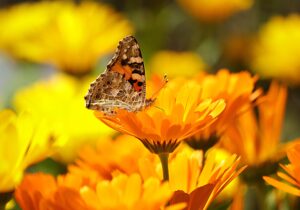
d. Attracts Pollinators
e. Aesthetic Appeal
III. Best Companion Plants for Rhubarb
1.Vegetables That Thrive Next to Rhubarb
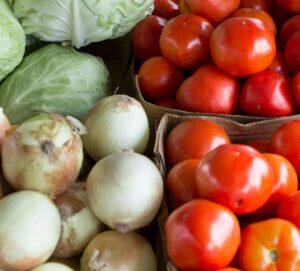
Companion planting with rhubarb can be highly beneficial for certain vegetables. Here are some of the best vegetable companions:
a. Garlic and Onions
These aromatic plants are believed to repel pests that might target rhubarb, offering a natural form of pest control.
b. Leafy Greens
Vegetables like lettuce, spinach, and Swiss chard benefit from the dappled shade provided by rhubarb’s large leaves.
This shade can help prevent them from bolting (going to seed) in hot weather.
c. Beans and Peas
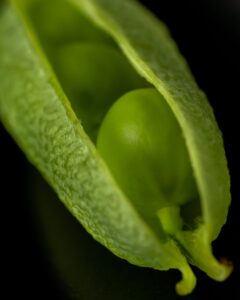
These legumes can fix nitrogen in the soil, which can be beneficial for rhubarb, which is a heavy feeder.
The vertical growth of beans and peas also makes efficient use of space when planted alongside the more horizontally spreading rhubarb.
d. Brassicas (Cabbage, Broccoli, Cauliflower)
While some sources suggest avoiding planting rhubarb near brassicas, others find that the deep roots of rhubarb do not compete with the shallower roots of these vegetables, making them compatible.
e. Flowers and Herbs as Rhubarb Companions
Flowers and herbs not only add beauty to your garden but can also offer practical benefits when planted with rhubarb:
f. Chamomile
Known for its ability to improve the flavor of neighboring plants and attract beneficial insects, chamomile is a great companion for rhubarb.
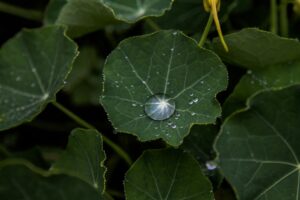
g. Marigolds
These bright flowers can deter pests and are believed to improve the overall health of the garden. Their vibrant colors also add visual appeal.
h. Nasturtiums
This plant is a well-known companion for many vegetables due to its ability to deter pests. It can also attract beneficial insects.
2.Why These Companions Work Well
The synergy between rhubarb and these companion plants is based on various factors:

a. Pest Deterrence
Some companions, like garlic and marigolds, naturally repel specific pests, reducing the need for chemical treatments.
b. Soil Improvement
Legumes like beans and peas improve soil nitrogen levels, which is beneficial for rhubarb as it is a nutrient-hungry plant.
c. Shade Provision
Rhubarb’s large leaves provide shade, which is beneficial for heat-sensitive plants like leafy greens, helping them to thrive even in warmer temperatures.
d. Attracting Beneficial Insects
Flowers like chamomile and nasturtiums attract pollinators and beneficial insects, which can help in pest control and overall garden health.
e. Spatial Efficiency
Utilizing different growth habits (like the vertical growth of beans and the horizontal spread of rhubarb) maximizes garden space and can lead to more productive use of the garden area.
By choosing the right companions for rhubarb, gardeners can create a mutually beneficial environment that maximizes yield, minimizes pest issues, and creates a diverse and attractive garden ecosystem.
IV. Plants to Avoid Planting Near Rhubarb
1.Incompatible Plants
Brassicas (Cabbage, Broccoli, Cauliflower, and Kale): Although there’s some debate, it’s generally advised to avoid planting rhubarb near brassicas. These plants have different nutrient needs and may not thrive when placed too close to rhubarb.
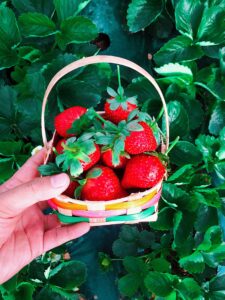
a. Strawberries
Strawberries are often cited as a poor companion for rhubarb. They share some common pests and diseases, which could be exacerbated when planted together.
b. Potatoes
It is recommended to avoid planting rhubarb near potatoes. The reason is not entirely clear, but it’s suggested that they might not grow well together.
c. Melons and Cucumbers
These plants prefer a different type of soil environment than rhubarb. Rhubarb’s large leaves might also overly shade these sun-loving plants.
2.Reasons for Incompatibility
a. Nutrient Competition
Some plants may compete with rhubarb for nutrients, particularly if they have similar nutrient needs or root depths. This competition can hinder the growth and health of both plants.
b. Disease and Pest Sharing
Plants that are susceptible to the same diseases and pests as rhubarb can create a risky environment where problems may spread more easily. For example, strawberries and rhubarb can both suffer from crown rot and other fungal diseases.
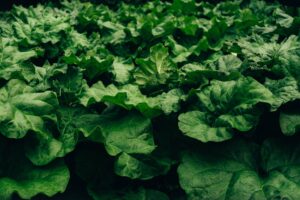
c. Different Growing Conditions
Rhubarb has specific soil, water, and light requirements. Plants that have drastically different needs might not be compatible. For instance, rhubarb’s large leaves can create too much shade for sun-loving plants like cucumbers and melons.
d. Allelopathy
Some plants release chemicals that can inhibit the growth of other plants. While rhubarb is not typically known for this, it’s still wise to consider potential chemical interactions in the soil.
e. Root Space Interference
Rhubarb has a deep root system, and planting it near shallow-rooted crops that spread horizontally, like strawberries, might lead to root space interference.
By carefully considering these factors, gardeners can make informed decisions about plant placement, ensuring that each plant in their garden has the best possible conditions for growth. Avoiding these incompatible plants when planning a garden with rhubarb will lead to a more harmonious and productive space.
V. Tips for Successful Companion Planting with Rhubarb
1.Soil and Sunlight Considerations
a. Soil Quality
Rhubarb thrives in well-drained, fertile soil rich in organic matter. Before planting, it’s beneficial to work compost or aged manure into the soil to improve its fertility and structure.
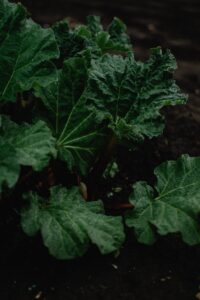
b. Soil pH
Rhubarb prefers slightly acidic to neutral soil, with a pH range of about 5.5 to 7.0. Testing your soil pH and adjusting it accordingly can help promote healthy rhubarb growth.
c. Sunlight Needs
Rhubarb grows best in full sun but can tolerate partial shade. However, too much shade can reduce the vigor and yield of the plant. Ensure that your rhubarb and its companions receive adequate sunlight, keeping in mind that rhubarb’s large leaves can cast significant shade.
d. Spacing
Proper spacing is essential for rhubarb and its companion plants.
Rhubarb needs ample room to grow, so plant it at least 3 feet away from other large plants.
This spacing allows adequate air circulation and reduces competition for nutrients and water.
2.Watering and Maintenance Tips
a. Watering Need
Regular watering is crucial for rhubarb, especially during dry spells. The soil should be kept moist but not waterlogged.
Overwatering can lead to root rot, so ensure good drainage.
b. Mulching

Applying a layer of mulch around rhubarb plants can help retain soil moisture, suppress weeds, and keep the root system cool. Organic mulches like straw or shredded leaves are ideal.
c. Feeding
d. Pruning and Cleanup
e. Pest and Disease Management
VI. Advantages of Companion Planting with Rhubarb
1.Enhanced Growth and Yield
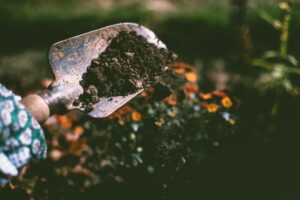
a. Improved Soil Conditions
Rhubarb can contribute to the improvement of soil quality through its deep root system, which helps in aerating the soil and enhancing its structure.
This, in turn, benefits neighboring plants by promoting healthier root growth and better nutrient absorption.
b. Shade and Moisture Regulation
The large leaves of rhubarb provide shade, which can be particularly beneficial during hot weather.
This shade helps to regulate soil temperature and moisture levels, creating a more favorable growing environment for plants that prefer cooler and moister conditions, such as leafy greens.
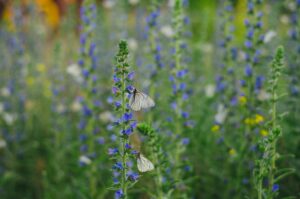
c. Nutrient Sharing
Rhubarb, when paired with nitrogen-fixing plants like beans and peas, can benefit from the additional nitrogen made available in the soil. This symbiotic relationship can lead to enhanced growth and yield for both the rhubarb and its companions.
d. Diverse Planting and Pollination
Including rhubarb in a garden increases plant diversity, which can lead to more effective pollination and higher overall yields, as a variety of plants can attract a wider range of pollinators.
2.Natural Pest Control
a. Pest Deterrent Properties
b. Attracting Beneficial Insects
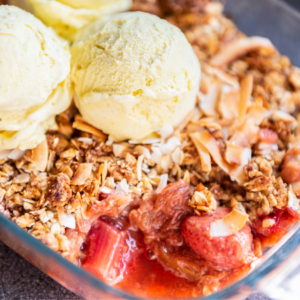
c. Reduced Need for Chemicals
d. Disease Prevention

VII. Real-Life Applications and Examples
Personal Experiences
Enhanced Vegetable Growth
Flavor Improvement
Aesthetic Value
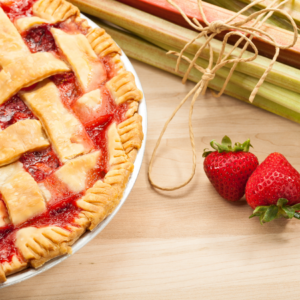
Case Studies
Community Garden Project
Organic Farming Research
Pest Control Observation

VIII. Troubleshooting Common Issues
Companion planting with rhubarb, like any gardening endeavor, can sometimes face challenges.
Two common issues are dealing with pests and addressing plant diseases. Here are some tips for troubleshooting these issues:
Dealing with Pests
Regular Monitoring
Natural Predators
Barriers and Traps
Neem Oil and Insecticidal Soaps
Companion Planting
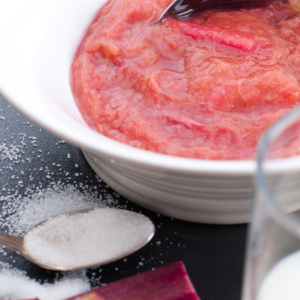
Addressing Plant DiseasesProper Spacing:
Watering Practices:
Mulching:

Crop Rotation:
Remove Infected Parts:
Fungicides:

IX. Harvesting and Utilizing Rhubarb
Rhubarb is not only a valuable plant for companion gardening but also a delightful addition to your kitchen. Here are some tips for harvesting rhubarb and creative ways to utilize this versatile vegetable.
1.Tips for Harvesting Rhubarb
Wait for Maturity:
Harvest rhubarb when the stalks are at least 10-15 inches long. This usually occurs in the second year after planting, as harvesting in the first year can weaken the young plants.
Harvesting Technique:
Gently twist and pull the stalks at the base to remove them. Avoid cutting as this can invite rot. Harvest no more than one-third of the plant’s stalks at a time to ensure the plant remains healthy and productive.
Best Time to Harvest:
The prime time for harvesting rhubarb is late spring and early summer. The stalks are at their most tender and flavorsome during this period.
Leave the Leaves:
Remember that rhubarb leaves are toxic and should not be consumed. Remove and compost the leaves, keeping only the stalks.
Regular Harvesting:
Regularly harvesting rhubarb can encourage further growth. However, taper off harvesting by mid-summer to allow the plant to store energy for the next season.

2.Creative Ways to Use Rhubarb
a. Rhubarb Pies and Desserts
b. Savory Dishes
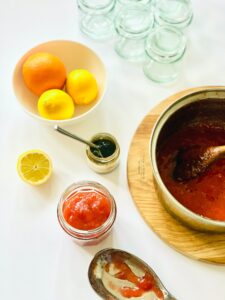
c. Rhubarb Jams and Preserves
d. Beverages
e. Pickled Rhubarb
f. Baking
g. Health Products
h. Dyeing Fabric

addition to your culinary repertoire.
X. Expanding Beyond Rhubarb
While rhubarb is a fantastic addition to any companion planting scheme, it’s just the beginning. Expanding your garden to include a variety of other plants suitable for companion planting can lead to a more productive, vibrant, and ecologically balanced garden. Let’s explore how you can build upon the foundation laid by rhubarb to create a diverse and thriving garden.
1.Other Plants Suitable for Companion Planting
a. Tomatoes
Known to benefit from being planted with basil, which repels pests like flies and mosquitoes and is said to improve the flavor of the tomatoes.
b. Carrots
Pair well with aromatic plants like rosemary and sage, which can help repel carrot flies. Chives and leeks also make good companions, helping to repel pests.
c. Beans
Great with corn and squash, in a classic companion planting trio known as the “Three Sisters.” The corn provides a structure for the beans to climb, while the squash spreads along the ground, deterring weeds.
d.
Benefit from companions like parsley and basil, which can enhance growth and flavor. Marigolds are also good neighbors, helping to repel pests.
e. Cucumbers
Do well with radishes, which can deter cucumber beetles. Marigolds and nasturtiums are also beneficial for repelling pests.
f. Lettuce
Thrives when planted with chives or garlic, as their strong scents can deter common pests.
g. Berries
Complement well with flowering plants like borage, which attract pollinators, essential for berry production.
2. Building a Diverse Garden
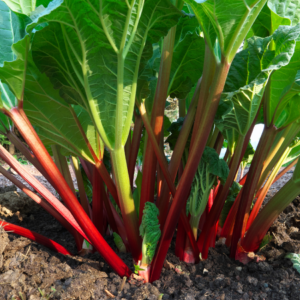
a. Understand Plant Relationships:
b. Plan for Pollinators:
c. Consider Plant Heights:
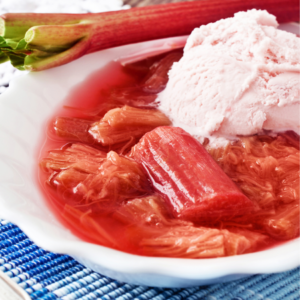
3. Integrate Perennials and Annuals:
a. Soil Health:
b. Watering Needs:
c. Regular Observation:
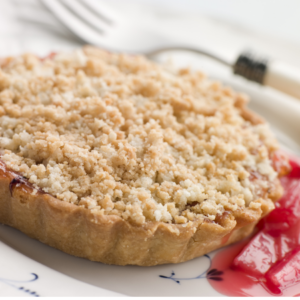
XI. The Future of Companion Planting with Rhubarb
Permaculture Practices:
Increased Biodiversity:
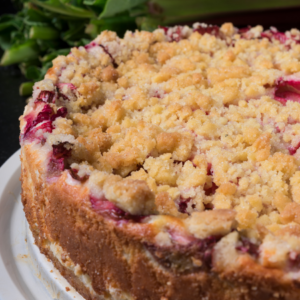
Technology in Gardening:
Educational Resources:
Sustainability and Eco-FriendlinessReduced Reliance on Chemicals:
Soil Health and Conservation:
Water Conservation: The shade provided by rhubarb’s large leaves can reduce water evaporation from the soil, promoting water conservation.

Carbon Footprint Reduction:
Wildlife Habitat:
The future of companion planting with rhubarb looks promising, with an emphasis on practices that are not only beneficial for garden productivity but also for the environment. As gardeners continue to explore and innovate, the role of rhubarb in sustainable gardening is likely to evolve and expand, making it a key player in the movement towards more eco-friendly and resilient gardening practices.
XII. Conclusion
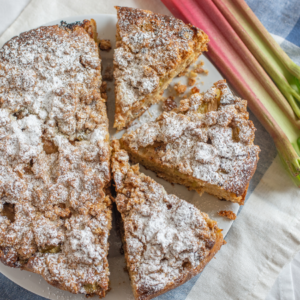
Recap of the Benefits
Companion planting with rhubarb offers a multitude of benefits, making it a valuable practice for gardeners of all levels. The key advantages include:
Enhanced Garden Productivity: Rhubarb’s companions, such as leafy greens, beans, and aromatic herbs, can experience improved growth and yield due to the favorable conditions rhubarb creates.
Natural Pest Control: Rhubarb can help reduce pest problems naturally, especially when paired with pest-repelling plants like garlic and marigolds.
Soil Health Improvement: The deep roots of rhubarb contribute to soil aeration and structure, while its large leaves can help maintain soil moisture.
Biodiversity and Ecological Balance: Introducing rhubarb into a companion planting scheme adds diversity to the garden, promoting a balanced ecosystem and attracting beneficial insects.
Aesthetic Appeal: Rhubarb, with its striking appearance, adds visual interest to any garden setting.
Sustainability and Eco-Friendliness: This practice aligns with sustainable gardening by reducing the need for chemical inputs and fostering a more natural, self-sustaining garden environment.
Encouragement to Try Companion Planting
For those who have not yet ventured into companion planting with rhubarb, I wholeheartedly encourage you to give it a try. Whether you’re a seasoned gardener or just starting, the integration of rhubarb into your garden can be a rewarding and enlightening experience. The versatility and benefits of rhubarb make it an excellent choice for companion planting, and its ability to improve the overall health and productivity of your garden is a journey worth exploring.
Remember, gardening is not just about the end result; it’s about the learning and growth that occurs along the way. Companion planting with rhubarb offers a unique opportunity to observe and interact with the natural world, understanding the intricate relationships between different plants and how they can support each other. So, roll up your sleeves, get your hands in the soil, and start your companion planting adventure with rhubarb. The rewards, both for your garden and for your personal satisfaction, can be immense.
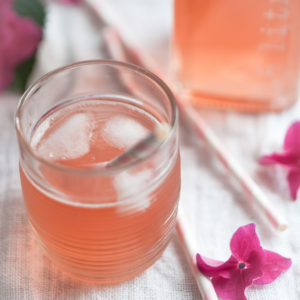
H2: Frequently Asked Questions (FAQs)
1. Can I plant rhubarb in my small garden or in a container?
Absolutely! Rhubarb adapts well to small gardens and can thrive in large containers. Just ensure the container is spacious enough for its root system, and place it in a sunny spot. Remember to water it regularly and provide adequate nutrients.
2. How do I know when my rhubarb is ready to harvest?
You can start harvesting rhubarb when the stalks reach at least 10-15 inches in length and are about 1 inch in diameter. This typically happens in the plant’s second year. Gently twist and pull the stalk at the base to harvest. Avoid harvesting all the stalks at once to keep the plant healthy.
3. What are the best companion plants for rhubarb in a vegetable garden?
Great companions for rhubarb in a vegetable garden include garlic, onions, beans, and leafy greens like spinach and lettuce. These plants benefit from the shade provided by rhubarb and can help with pest control.
4. How often should I water my rhubarb plant?
Water your rhubarb plant deeply once a week, ensuring the soil is moist but not waterlogged. During hot or dry periods, you may need to water more frequently. Always check the soil moisture level before watering.

